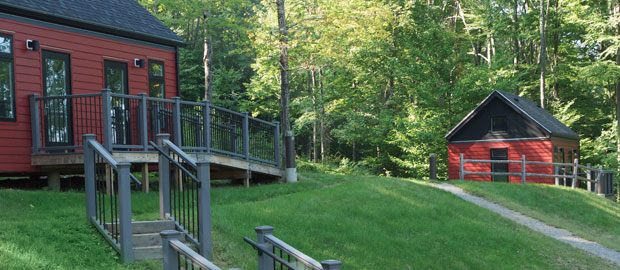
Here’s a riddle: How can you return but not arrive back at where you started?
Yellow Barn’s search for the answer to this riddle began in 2004 when it became necessary to find a new campus for Yellow Barn’s 5-week summer chamber music program, and the 18-day Young Artists Program that precedes it each June. Where would the participants be housed? Where would musicians practice, rehearse, take their meals, and enjoy the special camaraderie that is part of the Yellow Barn experience? Scarcely two years earlier, Yellow Barn’s longtime supporter, Mike McKenzie, had completed construction of an acoustically superb hall. Audiences could now enjoy Yellow Barn concerts in the Big Barn, an airy and air-conditioned space with room for fine pianos on and off stage and comfortable seats for our ever-savvy concert attendees. Would Yellow Barn have to leave the community that had been so welcoming during 35 previous seasons and start anew in some as yet unknown location? Those questions and many more confronted the people entrusted with Yellow Barn’s past, present and future: its artistic director and faculty, the staff and trustees, its local supporters, and those from outside the immediate community who knew about Yellow Barn through its growing reputation.
For three summers, Yellow Barn travelled the I-91 corridor, finding temporary housing for musicians and faculty at Amherst College, playing concerts in the college’s Buckley Hall and returning “home” to Putney twice weekly to play in Big Barn. The challenge of finding a suitable campus was ever-present and elusive. Yellow Barn and the Greenwood School in Putney had been meeting over a number of years to discuss a summer home for Yellow Barn on the Greenwood campus. The commitment and ideals of the Greenwood faculty and staff seemed to make the school and its campus an environment perfectly suited to the Yellow Barn community, but while the size and beauty of the campus felt like it could be our home, rehearsal and dormitory facilities did not quite meet the challenging demands of a music festival.
In 2008 an enormous piece of the campus solution came in the shape of eight remarkable, pre-fabricated and environmentally-friendly rehearsal studios and practice rooms that not only worked well for Yellow Barn musicians during the summer, but could serve as all-important tutorial and classroom spaces for faculty and students at The Greenwood School. Those are the tangible elements to the elusive campus. The intangible, and possibly more critical elements were the willingness and commitment of certain people to keep talking, keep listening, and keep dreaming. Many of those people are recognized in the naming of the studios written of below.
The original riddle: returning but not going back. With the existence of the Yellow Barn studios an exciting new program was born – Artist Residencies that serve Yellow Barn’s mission, serve some of the curricular goals of The Greenwood School and serve the larger Putney community. Some of those Yellow Barn residencies have traveled to other venues far beyond Putney: to the Nasher Sculpture Center in Dallas, Texas, to venues in Boston, New York, Washington, D.C. and Stockton, California. Coming back to Putney has meant the stability of home joined with the ability to carry Yellow Barn’s dreams to distant places.
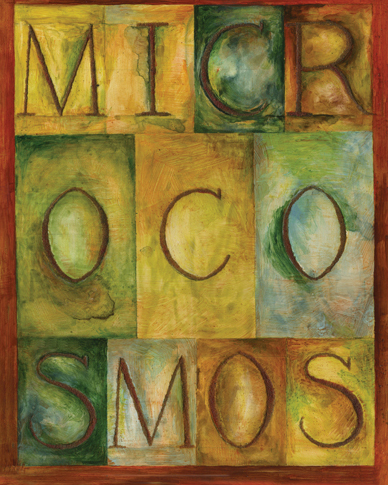
Microcosmos
The inspiration for this name came from Béla Bartók's Mikrokosmos, a cycle of 153 short piano pieces that he composed in the 1930's. Ranging from simple pieces for the musical instruction of his nine-year-old son to challenging pieces suitable for the concert hall, these pieces were written with the didactic intent to present to the performer as well as to the listener a small cosmos of modern music. They include many melodic and rhythmic quotations from Bartók's extensive researches into folk music, translated into the complex musical language of the early twentieth century. Thus the cycle also serves as a bridge of sorts from the traditional roots of music into the intense musical spirit of Bartok's own time.
In its own way, Yellow Barn today continues this tradition of presenting its musicians and its audiences with a small cosmos of the musical spirit of our own time. This small cosmos today has of course evolved beyond what it was in Bartók's time, yet the name still seems appropriate for this small studio where participants work so hard to shape their own encounter with this living musical universe. Changing the spelling to 'Microcosmos', a somewhat infrequent variant of 'microcosm', seemed a way to preserve Bartók's perspective while simultaneously translating it into an American idiom and removing any limitations that an explicit reference to a specific piece from a specific era might otherwise have implied. And for some it may even awaken an association to the old notion of the human being as an entire universe in himself or herself, something that is reflected in Yellow Barn's wholistic approach to the development of musicians.
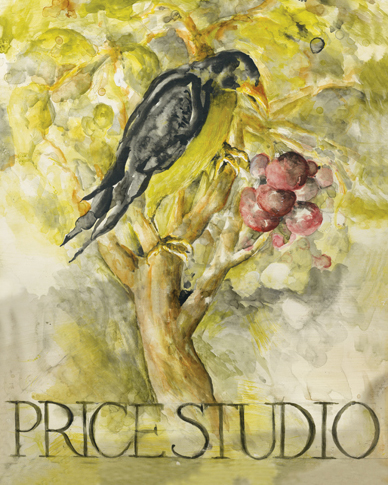
Price
Charles and Jessie Price became acquainted with Yellow Barn during years of significant artistic growth but when our desire to find a campus “home” in our place of origin was proving difficult to satisfy. As people who fill their lives with architecture, art, and music, curiosity for the music we program and interest in our artists soon led Charles and Jessie to become close friends of Yellow Barn. Their support has made an extraordinary difference in the lives of Yellow Barn’s musicians, and this studio reminds us that the care and respect with which we approach music inspires care in those who listen.
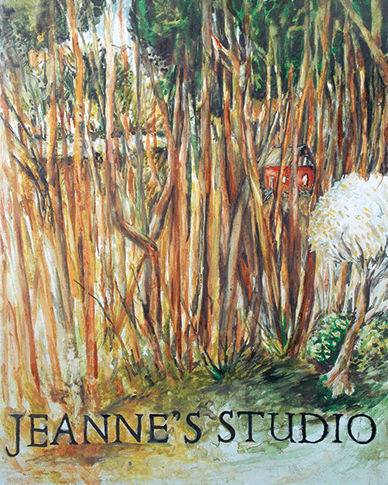
Jeanne's
Jeanne Cowles Fleischmann Bruce – writer, painter, wife, mother, grandmother. She always saw the rainbow rather than the mist, finding good in each of us. "Half Pint" (1952) a young-adult story grew from summers on a Wyoming ranch written while married to Dr. Philip Wilson. Her longest association was with the New Yorker Magazine, starting as the personal assistant to legendary editor William Shawn before she married Peter Fleischmann, New Yorker president. She painted at the Art Students League in New York for many years and then with her final love, British painter George Bruce. Although her original paintings remain in the collections of her family members, many of her best ones were reproduced and shared with her friends through her annual Christmas cards
When fortune came she was generous. That generosity, though, was always hers. Whenever she's remembered it's always with a smile.
Jeanne never visited Yellow Barn, though she loved both music and her nephew who was involved with Yellow Barn. She's remembered here because the beauty of Vermont and the artistry that emerges from practice and inspiration were the stuff of which she spun her life.
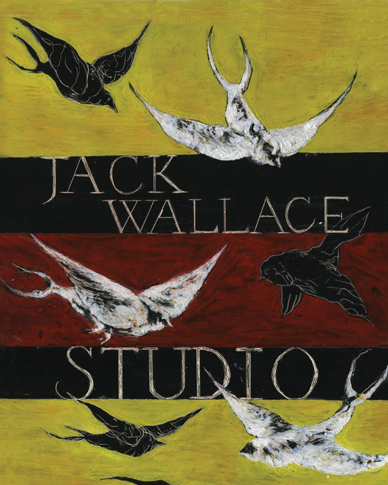
Wallace
Jack Wallace was a 50-year resident of Putney, but a citizen of the world. He moved here in 1956 to work for World Learning, when it occupied what is now the Greenwood School campus (and the field now dotted with pods was then dotted with cows.) An educator by profession and motivation, he was interested in experiential and intercultural education. He worked for World Learning for 25 years, and founded its School for International Training. In the course of his work he travelled to 100 countries in order to further international understanding and world peace. He was also very active in civic affairs in Putney, most notably being the Moderator of Town Meeting for 25 years.
He was a stalwart friend of the Yellow Barn from its beginning. By no means a musician, he greatly enjoyed listening to concerts in the barn, and was proud that the little town of Putney was home to a top-notch musical institution. He was a long-time Yellow Barn trustee, and was a trusted advisor and wise counselor to all for many more years.
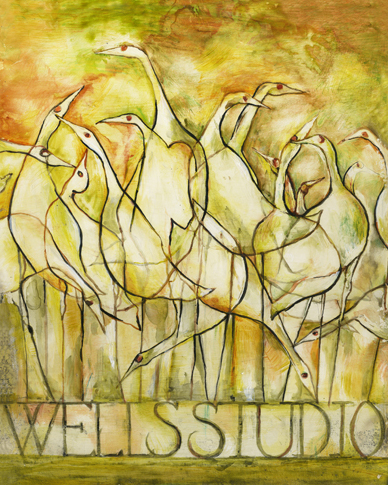
Wells
In 1969 David and Janet bought a house with an attached barn in Putney, Vermont, with the idea of having students come in the summer to make music. That same year, about twelve students came to live with the Wellses for the first season of what would become the Yellow Barn Music Festival. The goal was to provide professional training and performance experience for aspiring young musicians in a supportive environment, while making chamber music available to the local community. This goal was not only realized but brought into abundant life through the Wells’ passion for music, their love of their community, and their devotion to meeting each participant’s needs at many levels—giving ample opportunity for work, play, nourishment, and rest.
Central to their mission was David and Janet’s belief in the dignity of the individual. This was not just an ideal: it was a way of life. Whether participant, faculty, staff, or community; young or old, student or professional, novice or prize-winner—all were valued. Ensembles included seasoned artists playing with less experienced musicians; dessert receptions were held for participants and community to mingle and bond; staff members were recognized and warmly appreciated for their invaluable behind-the-scenes work; meetings were called to resolve conflicts and address concerns. Everyone did their best; everyone was family; all were loved.
As the Wellses nurtured every aspect with their care and their artistry, Yellow Barn became one of the most special places for musicians to spend the summer. Not surprisingly, like an offspring that lives on to fulfill its purpose, Yellow Barn matured to become its own distinct entity. Now with a new director and a new home, Yellow Barn’s mission is to continue the special life-giving place that is David and Janet’s enduring vision.
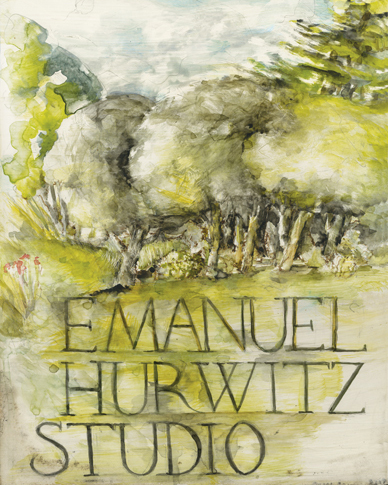 Hurwitz
HurwitzThose who were lucky enough to know Manny were really blessed. He was a hugely special player and teacher and drew from a great breadth of experience as leader of the Aeolian Quartet, Melos Ensemble, soloist and concertmaster of the English Chamber Orchestra. As a teacher, he applied his vast wisdom with humility and economy, his advice expertly targeted. He recounted numerous stories of the great players of the past, many of whom he knew personally. His wit was breathtaking - laughter was part of his medicine - and his modesty was part of his skill: "I am not a great player, I just try to sound like one".
Manny was without doubt a great man and a very important musician. He loved Yellow Barn and would have been enchanted by the location in which we currently enjoy working. In my teens I was privileged to be his pupil for three years, but his influence on me was deep and lasting.

Nathan's
Nathan Schwartz had a consummate knowledge of all music through his study with some of the finest scholars and composers of the mid 20th Century, with added inspiration from his studies with Alfred Cortot in Europe. It was, however, in the communication of music through performance and teaching, that he chose to spend his life.
A founding member of the Francesco Trio for nearly forty years, he performed internationally almost all the piano chamber music and was responsible for the commissioning and recording of many contemporary works. His performances brought with them not only great understanding of musical thought, but a special quality of beauty of piano sound, a clarity of articulation, and a wonderfully joyful energy and enthusiasm in shear music-making.
During the last two summers of his life, he brought this to Yellow Barn, with an appreciation for the spirit of the Festival and for Seth Knopp, a former student and well-loved colleague, and a joy in the openness and receptiveness of the young artist participants. While he was experiencing health challenges, it was the Music which gave him the energy to experience the renewal of love and life which was the source of his inspiration.
About Yellow Barn's Studio Signs
During its history the Yellow Barn family has included artists from many disciplines, including painters, photographers, and writers. Since the late 1990s we have had the honor of Bill Kelly's artistry and friendship. Bill's relationship with Yellow Barn began when both he and Yellow Barn were residents at the Putney School and Seth Knopp invited his students to come to the original Yellow Barn to draw musicians in rehearsal. A few years later Bill began working with Yellow Barn participants to transform Yellow Barn's unique wall programs into extraordinary works of art. When the studios were created in 2008, it was only natural that Yellow Barn would ask Bill to help celebrate their arrival by creating the beautiful signs that pay tribute to the people and the spirits that make the Greenwood School our home.
Bill Kelly is a painter, printmaker, and sculptor as well as co-director of Brighton Press – an internationally-known fine press artists’ book publisher, which he founded in 1980. Brighton Press books are housed in over one hundred museum and library collections. Kelly received his MFA in Studio Arts from Johnson State College in Vermont and teaches drawing and printmaking at the University of San Diego, as well as letterpress printing at San Diego State University. His personal work is housed in numerous public and private collections in the United States, including the Achenbach Foundation for the Graphic Arts in San Francisco, the Getty Research Institute in Los Angeles, the Walker Art Museum in Minneapolis, and the Toledo Art Museum in Ohio. Kelly was awarded a Pollack Krasner Foundation Grant in 2002 and continues making art and books in Vermont and California.
